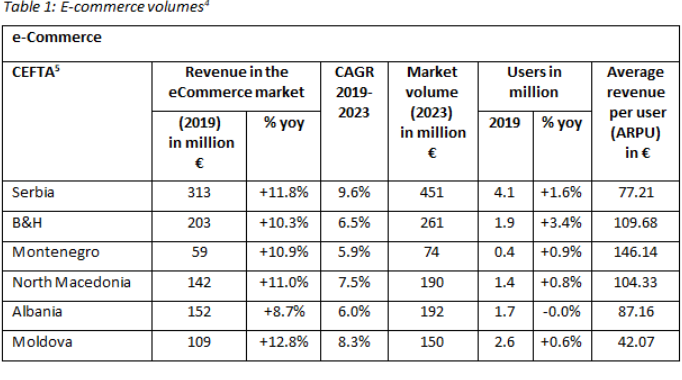According to the latest CEFTA research, the citizens of Macedonia are leaders in online shopping in the region if we take into account the number of inhabitants and GDP of each country. However, the e-commerce market has much greater potential, which in order to be used requires the introduction of regulatory changes throughout the CEFTA region. The latest roadmap adopted by CEFTA recommends introducing a common regional market that will bring greater opportunities for progress.
E-commerce is becoming an important link in the trade framework, due to its high potential for boosting economic growth, digital transformation and the benefits it brings to the citizens. The global value of e-commerce reached $29 billion in 2017, or 36 percent of the global GDP.
The European Union ranks second in global e-commerce sales and leads in the UNCTAD e-commerce index, which measures the extent to which economies are willing to support online shopping. In the list of 152 economies, Europe has 8 of the top 10 places, of which 6 are EU member states.
WHAT IS THE STATUS OF THE CEFTA COUNTRIES?
As in many other segments, the countries in the region, which are part of the CEFTA agreement, are lagging and have not used the full potential of e-commerce, according to the latest CEFTA research.
Some estimates show that CEFTA’s e-commerce physical goods market is worth about 1 billion euros and is growing at a double-digit rate. E-commerce of services and digital products is far less developed and is estimated at 84 million euros. The most common services purchased online are online delivery, event tickets, applications, etc.

From this table it is clear that the e-commerce market in Macedonia in 2019 amounted to 142 million euros, and Macedonians spent an average of 104 euros for e-shopping. A total of 1.4 million citizens shopped online in 2019.
CEFTA recommends that the regulatory and policy environment be improved to facilitate and promote e-commerce in the CEFTA region. The OECD reports on 6 poor results by CEFTA countries in creating a friendly e-commerce environment for small and medium-sized companies, especially in terms of implementing and monitoring policies and regulations.
WITHOUT CHEAP AND SAFE WAYS FOR ONLINE PAYMENT, CITIZENS AND BUSINESSES WILL NOT DEAL WITH E-COMMERCE
Performance in terms of online payment prerequisites, such as account ownership, varies considerably in the CEFTA countries, with some making up barely 50% of the adult population. CEFTA has generally made good progress in accessing payment instruments, although current results suggest that the efforts should be continued. Major international service providers, such as PayPal, are either not present in the market or their services are limited, as they do not have a local license. The regulatory environment for payments is relatively developed, but more needs to be done to comply with relevant EU regulations.
In terms of having accounts for online payments, Macedonians are leaders in CEFTA. As many as 77 percent of adults in Macedonia have an online payment account, and 49 percent of citizens have made at least one online payment in the past year.

The director of CaSys AD Macedonia, Filomena Pljakovska-Asprovska says that the Republic of North Macedonia has a safe, secure, reliable and resilient digital environment, supported by quality facilities, highly qualified experts, built level of trust and national and international cooperation in the field of cyber security.
According to the statistics and analysis for 2019 with the growth of the use of information and communication technologies where 90% of the population uses the Internet – and 84.% and 81.7% through a computer there is concern about possible misuse.
“But let us not be too worried because of the total population, 75% take certain security measures when using the devices, and 60% know what cyber security is. The analysis also shows a rapid growth in the number of virtual traders of 29% in the third quarter of 2020 compared to 2019 and the number of transactions is 61% higher in the third quarter of this year compared to last year which reflects the change in customer habits and the need for electronic payment channels”, says Pljakovska-Asprovska.
WITHIN CEFTA REGION WITHOUT TARIFFS FOR E-COMMERCE TO THE USE OF THE FULL POTENTIAL
Sport Vision e-commerce director Zorana Milidrag says that digital customers are the most complex, and in this region, we still need to continue working on the overall digital ecosystem. Continuous and long-term education of both customers and traders in e-commerce is the key to progress.
“One of the biggest challenges in e-commerce is the professional development of employees. People in our region do not have enough experience and knowledge in e-commerce, while customers behave intuitively, and they are always one step ahead of us. We need to change that because we need to lead the game.”
Regarding what needs to be done to improve the e-market, she says the solution is to create a larger market by introducing a CEFTA region without e-commerce tariffs.
“If we want proper growth of e-commerce in our region, we need centralization. With a centralized approach we can get more improvements. To do that, we need better logistics infrastructure and better services. Second, but no less important, governments need to change and adjust procedures. If we want a seamless customer experience, we need to have a great on-site experience and fast delivery. There is a part that needs to be improved by the business itself, and there is a part and procedures that governments need to change.”
WHAT DOES CEFTA RECOMMEND TO IMPROVE THE E-MARKET IN THE REGION?
In its latest research and analysis, CEFTA provides guidance on how the potential of e-commerce in the region can be further exploited. The things that need to be done are classified into the following points:
– Compliance: identifying key rules and standards that will create a good basis for cross-border e-commerce, which will be the basis for building a trustworthy and enabling environment
– Market integration: introducing principles that will allow companies to operate in multiple markets without having to move through a variety of regulatory frameworks, e.g. mutual recognition arrangement or internal market principle
– Transparency and facilitation – setting up transparency instruments that will provide relevant information to regulators and businesses to reduce costs related to information asymmetry, as well as special procedures that will enable more efficient compliance with regulatory requirements
– Institutional and administrative cooperation refers to cooperation between regulators and policy makers, for building trust and effective management of cross-border issues, as well as setting up regional instruments that will facilitate cooperation in the administration and implementation of commitments (eg setting up electronic data exchange system)
CEFTA expert Zdravko Ilic explains that the CEFTA e-commerce roadmap, approved this year, is built around 4 groups of barriers, identified in close cooperation with business organizations, such as e-commerce associations, chambers of commerce and companies directly. He says their job is to bring CEFTA’s seven markets into a common regional market, which will be accessible to all companies in the region.
“We can do that by minimizing the costs. Based on the experience from the EU, we want to enable all our companies their compliance with domestic rules to comply, to a large extent, with the rules of the region. For this to happen, we need to agree on common rules based on those of the EU, which will apply equally to the whole region. Next, we need to establish transparency in postal delivery prices and promote co-operation between carriers, in order to have efficient delivery from one CEFTA market to another.”, says Ilic.
Ilic adds that the benefits of a common regional market will be huge for all.
“The entire CEFTA markets are estimated at one billion euros with 20 million consumers. This is a market that can motivate companies to invest in the tools and people needed to digitize their business. Small markets attract small investments that result in lagging behind our EU peers. Providing a large enough market for an e-commerce company means helping them transform into the potential of the digital economy, ie. to reach consumers around the world via the Internet, Internet marketing tools, an uninterrupted open trade facility and the ability to focus on targeted markets. For small companies that do not have enough resources to invest in agents and fairs, the online store may be the only way to export.”, says Ilic.

